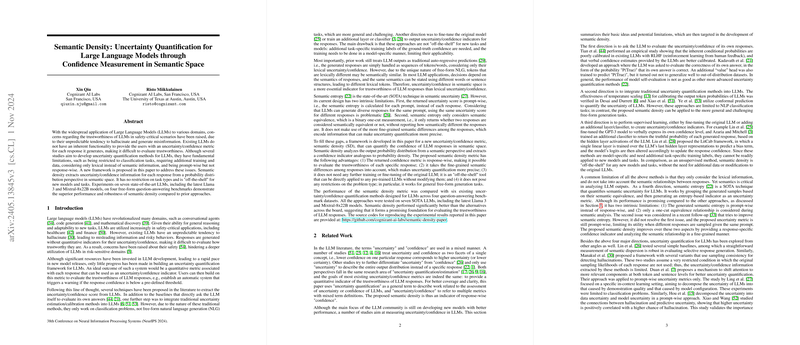Analysis of "Semantic Density: Uncertainty Quantification for LLMs through Confidence Measurement in Semantic Space"
LLMs have become ubiquitous in a variety of domains, leveraging their capabilities in understanding and generating human-like text to perform tasks in conversational agents, code generation, and even mathematical discovery. Despite their widespread adoption, a critical challenge remains: the tendency of LLMs to hallucinate, producing unreliable and incorrect outputs, particularly in safety-critical applications such as healthcare and finance. The paper "Semantic Density: Uncertainty Quantification for LLMs through Confidence Measurement in Semantic Space" by Xin Qiu and Risto Miikkulainen proposes a novel framework aimed at addressing these challenges by quantifying uncertainty through semantic confidence metrics.
Key Contributions
The cornerstone of this paper is the introduction of Semantic Density (SD), a metric designed to quantify the confidence of LLM outputs by analyzing semantic space rather than relying solely on lexical tokens. This approach diverges from traditional uncertainty quantification methods which are often restricted to classification tasks and require additional training or specific data.
Core Advantages:
- Response-wise Evaluation: Unlike previous approaches, SD provides confidence metrics for each specific response rather than treating sentence-level outputs as atomic lexical sequences.
- Off-the-shelf Utility: The proposed framework does not require further training or model adjustments, allowing it to be seamlessly integrated with any pre-trained LLM.
- Task Type Versatility: SD is applicable across various forms of Natural Language Generation (NLG), including open-ended question answering, which conventional methods struggle to address accurately.
Methodology and Implementation
Semantic Density estimates the confidence of LLM outputs by considering the probability distribution of a model’s response in a semantic space constructed via contextual embedding models. A noteworthy feature of SD is its use of kernel density estimation (KDE) tailored for discrete outputs. The kernel function employed captures fine-grained semantic variances effectively while remaining dimension-invariant, ensuring compatibility with varied text embedding methods.
To compute SD, the researchers employ a Natural Language Inference (NLI) model which assesses semantic relationships among generated responses, offering probabilities of semantic alignment (entailment), irrelevance (neutral), or contradiction. This process facilitates an enriched understanding of the semantic distribution, thereby enabling more precise confidence quantification.
Experimental Evaluation
The paper robustly evaluates SD against six existing uncertainty quantification techniques across seven state-of-the-art LLMs and four renowned datasets. The evaluation emphasizes two performance metrics: AUROC and AUPR, which measure the reliability of confidence scores in identifying correct versus incorrect outputs. The results demonstrate that SD consistently outperforms other metrics in accuracy and robustness, reaffirming its utility in diverse conditions, including tasks beyond question-answering, such as summarization.
Implications and Future Directions
The introduction of Semantic Density opens avenues for more reliable deployment of LLMs in sensitive domains. By equipping LLMs with the ability to self-assess the trustworthiness of their outputs, this metric addresses a significant barrier to their broader application. Practically, SD offers a direct path for enhancing LLMs' operational integrity, potentially integrating as an alert mechanism or filtering criterion in scenarios where output reliability is paramount.
Future research directions could explore refining the semantic space modeling, enhancing sampling strategies for generating references, and investigating the scalability of SD in handling longer, more complex responses. Additionally, advancements in personalized kernel functions could further improve the efficacy and flexibility of uncertainty quantification.
In conclusion, the semantic density framework provides a promising solution to one of the fundamental challenges faced by LLMs today—evaluating response confidence in a reliable and task-agnostic manner. This innovation not only contributes significantly to the field of AI safety and trustworthiness but also sets the stage for further research into semantic representations and confidence measurement.
